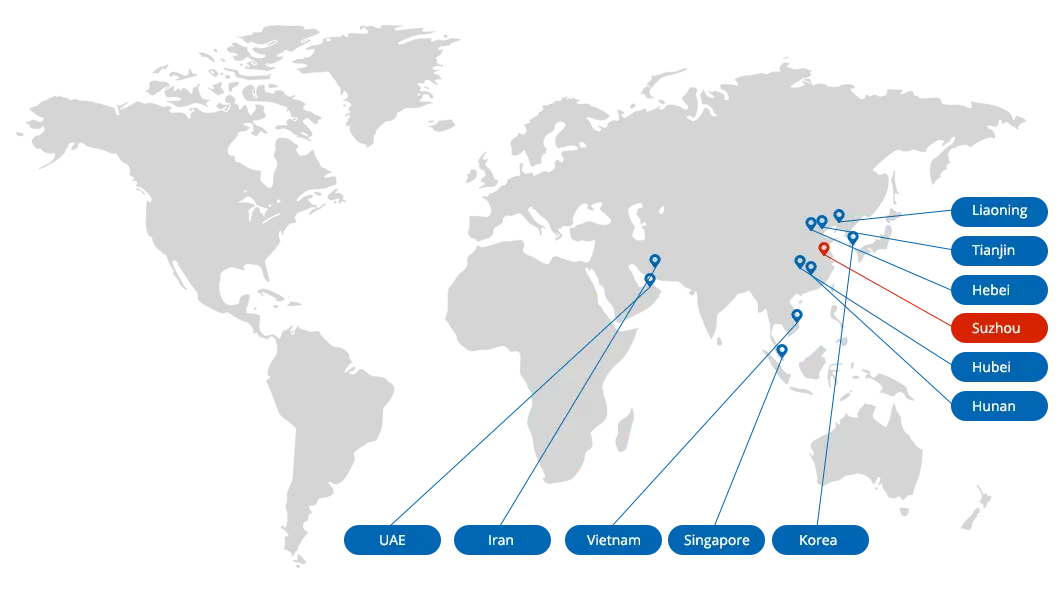| Product: | carbon steel plate, carbon steel sheet,stainless steel plate |
| Application: | Construction structure, water transport and sewage treatment, thermal industry, buildings etc |
| Size: | Thickness:0.2-500mm,etc |
| Width:1000-4000mm,etc | |
| Length: 2000mm, 2438mm, 3000mm, 3500,6000mm,12000mm | |
| Pipe Standard: | ASTM,AISI,JIS,GB, DIN,EN |
| Material: | A106 A-B、Q195、Q215、Q235B、Q255A、Q275、08F、45#、20#、Q295、A516 GR.70、Q345A-B、Q420、Q460E、T7、T12A、T8Mn、DR510-50、DRI750G-35、25CrMoVA、30CrMnSi、 50CrVA、4CrW2Si、SS400、A36、SM400A、P235GH、P295GH、St37-2、SA283Gr、S235JR、S235J0、S235J2, |
| Technique | Cold Rolled, Hot Rolled |
 Steel plate Introduction
Steel plate Introduction
|
Product: |
Stainless Steel Sheet, 304 Stainless Steel Plate, 316 Stainless Steel Plate |
|
Application: |
In Chemical Industry, Coal, Oil Field Open Machine, Building Materials Heat-resistant Parts |
|
3/16'' Thick ~ 6'' Thick, Up to 120'' Wide |
|
|
Pipe Standard: |
ASTM A167, ASTM A176, ASTM A240, ASTM A693, ASTM A480 |
|
Steel Grades: |
300 Series Stainless, 400 Series Stainless |
|
Surface: |
Sweet Service, Sour Service, Anti-H2S, NACE MR0175/ISO15156 |
|
Zinc Coating: |
10~50 g/m2 |
|
Packing: |
Waterproof Paper Wrapped, Packed in Wooden Cabins |
 Tensile strength, elongation, hardness, and bending tests of skin-passed materials (S)
Tensile strength, elongation, hardness, and bending tests of skin-passed materials (S)
|
Remarks |
Steel type |
Tensile strength, N/mm2 |
Elongation, % |
Hardness |
Bending test |
|||||||
|
Classification by nominal thickness, mm |
Takasago special standard |
|||||||||||
|
0.25≤ |
0.25≤ |
0.30≤ |
0.40≤ |
0.60≤ |
1.0≤ |
1.6≤ |
2.5≤ |
HV |
HRBS |
|||
|
General |
SPCC-SB |
- |
- |
- |
- |
- |
- |
- |
- |
≤115 |
≤65 |
Bend angle: 180° |
|
SPCCT-SB |
270≤ |
26≤ |
29≤ |
32≤ |
34≤ |
35≤ |
36≤ |
37≤ |
≤115 |
≤65 |
||
|
Drawing |
SPCD-SB |
270≤ |
28≤ |
31≤ |
34≤ |
36≤ |
37≤ |
38≤ |
39≤ |
≤115 |
≤65 |
|
|
Deep drawing |
SPCE-SB |
270≤ |
30≤ |
33≤ |
36≤ |
38≤ |
39≤ |
40≤ |
41≤ |
≤115 |
≤65 |
|
* No. 5 test pieces are to be used for tensile testing.
 Hardness and bending tests of hardened materials
Hardness and bending tests of hardened materials
|
Skin-pass |
Skin-pass symbol |
Rockwell hardness |
Vickers hardness |
Bending test |
||
|
HRBS |
HV |
Bending angle |
Inner radius |
Bending test piece |
||
|
1/8 hardness |
8 |
50 - 71 |
95 - 130 |
180° |
Adhesion |
JIS No. 3 test piece |
|
1/4 hardness |
4 |
65 - 80 |
115 - 150 |
180° |
Half of thickness |
|
|
1/2 hardness |
2 |
74 - 89 |
135 - 185 |
180° |
Equal to thickness |
|
|
Full hard |
1 |
85≤ |
170≤ |
- |
- |
|
* Normally, the bending test is omitted.

 Tensile Test
Tensile Test
By definition, tensile is defined as the capability of a material to become stretched or drawn out until cracks or stresses begin to show. Another more common term is “tensile strength” which is the resistance of breaking under impacts or stresses. This term is used to describe the limit at which steel or any ductile material transforms from temporary elasticity to permanent deformation. To put it simply, when a material has been stretched past its tensile strength rating, it will break apart.
In sheet metal fabrication, undertaking tensile tests or tensile strength tests is important because it predicts the reproducibility of a given product. This is especially useful for the mass production of metal goods, wherein each product must have relatively the same measurements for tensile strength. For example, even if a single sheet of a metal coil is formed in the same facility, material characteristics will still vary, affecting the quality of the part and scrap rate.
As one of the most common methods for testing metal, tensile strength tests are widely available and can be done on universal testing machines (UTMs) that are also capable of other types of mechanical tests. In this case, a small sample of sheet metal is loaded into the machine and drawn out. The operator records the specimen’s maximum load values, as shown on a computer screen.
 Fatigue Test
Fatigue Test
Another type of metal testing method is known as the fatigue test. Unlike tensile strength tests where a specimen is subject to only a single complete execution, fatigue testing is done under a cyclical load that constantly adds stress to the material. This is done at a certain frequency or alternating load tests in order to measure tension or compression.
Material failure in fatigue testing takes place when damage begins showing on the specimen after being subjected to frequent repetitions of stress. This type of testing is crucial in understanding why metal components that have been used for long periods may suddenly fail. Oftentimes this failure occurs not because of a single overload, but a continuous pattern of cyclical stress drawn out for a certain timeframe.
Fatigue testing methods can be further subcategorized into a high cycle or low cycle testing. For the high cycle test, the finite life fatigue strength and the high cycle fatigue strength are determined. Some examples of these two types in action can be found in turbine blades or stationary power-generating turbines that undergo disc strain when in constant use.
 Hardness Testing
Hardness Testing
Most mild steel or low carbon steel sheet metals that are 1.5 millimeters in thickness will most likely have a Rockwell B hardness rating. Rockwell hardness is simply the measuring range that determines the resistance of a material to permanent deformity and penetration by another material. This is usually done for certain types of steel, such as tool and cutting steel which is engineered to be more durable than the typical.
As mentioned before, mild steel will record a Rockwell B hardness rating that falls in the mid to high 70s. Three main components are involved in this type of testing — the indenter, anvil, and the specimen. Here’s a brief illustration of the process:
The minor load is pressed onto the specimen and generates a reference depth for the measurement. For Rockwell B, around 10 kg/cm2 of force is used.
To achieve a deeper penetration, an additional load is pressed onto the surface of the sheet metal. It is removed then a minor load is re-applied.
The Rockwell B hardness rating is calculated by measuring the difference between the depth and the reference depth done on the material.
 Hole Expansion Test
Hole Expansion Test
Hole expansion testing is specific for punched sheet metals and is done to assess the ductility (the ability of the material to be formed into a wire without breaking) on the sheet metal’s edges. This method is applicable especially for high-strength steel products, which face challenges on edge cracks, especially when sheared.
The hole expansion test starts off with shearing a 10mm-diameter hole and widened using a conical punch at 60°. The resulting ratio of the expanded diameter to the initial measurement is subsequently known as the hole expansion ratio. Since shearing creates significant alterations to the material’s forming properties for sheet metal edges, this technique proves to be a fast and economic way of measuring the change.
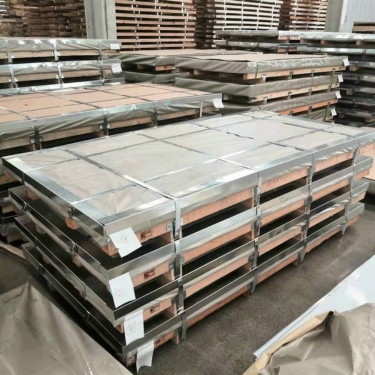
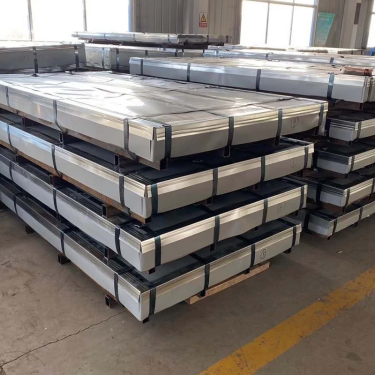
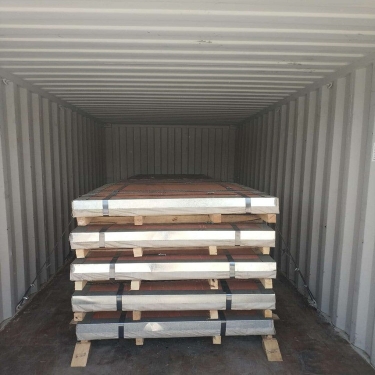
 Steel Sheet Thickness tolerances
Steel Sheet Thickness tolerances
|
Unit: mm |
||||||||
|
Classification by nominal thickness |
JIS G 3141 thickness tolerance B |
Takasago special standard |
||||||
|
|
160≤ |
250≤ |
400≤ |
S standard |
SS standard |
U standard |
||
|
0.25≤ |
<0.40 |
±0.025 |
±0.030 |
±0.035 |
±0.035 |
±0.015 |
±0.012 |
±0.010 |
|
0.40≤ |
<0.60 |
±0.035 |
±0.040 |
±0.040 |
±0.040 |
±0.020 |
±0.016 |
|
|
0.60≤ |
<0.80 |
±0.040 |
±0.045 |
±0.045 |
±0.045 |
±0.023 |
±0.018 |
±0.012 |
|
0.80≤ |
<1.00 |
±0.04 |
±0.05 |
±0.05 |
±0.05 |
±0.026 |
±0.020 |
±0.014 |
|
1.00≤ |
<1.25 |
±0.05 |
±0.05 |
±0.05 |
±0.06 |
±0.030 |
±0.022 |
±0.016 |
|
1.25≤ |
<1.60 |
±0.05 |
±0.06 |
±0.06 |
±0.06 |
±0.035 |
±0.025 |
±0.018 |
|
1.60≤ |
<2.00 |
±0.06 |
±0.07 |
±0.08 |
±0.08 |
±0.040 |
±0.030 |
±0.020 |
|
2.00≤ |
<2.50 |
±0.07 |
±0.08 |
±0.08 |
±0.09 |
±0.050 |
±0.035 |
±0.030 |
|
2.50≤ |
<3.15 |
±0.08 |
±0.09 |
±0.09 |
±0.10 |
±0.060 |
±0.040 |
- |
|
3.15≤ |
<4.00 |
±0.09 |
±0.10 |
±0.10 |
±0.11 |
±0.070 |
±0.050 |
- |
|
4.00≤ |
<5.00 |
±0.10 |
±0.10 |
±0.11 |
±0.11 |
±0.08 |
±0.06 |
- |
|
5.00≤ |
<6.00 |
±0.12 |
±0.12 |
±0.13 |
±0.13 |
±0.09 |
±0.07 |
- |
|
6.00≤ |
≤7.00 |
±0.15 |
±0.15 |
±0.17 |
±0.17 |
±0.10 |
±0.08 |
- |
Notes
1. The thickness of a steel strip is typically measured at a point within 15 mm of the edges. For pieces less than 30 mm in width, thickness is measured at the center.
2. To order sizes not listed above, please feel free to contact us.
3. Costs are higher for products made to meet special standards (SS and U).
 Steel Sheet Width tolerances
Steel Sheet Width tolerances
|
Unit: mm |
|||||
|
Classification by nominal thickness |
JIS G 3141 width tolerances C |
||||
|
<160 |
160≤ |
250≤ |
400≤ |
||
|
|
<0.60 |
±0.15 |
±0.20 |
±0.25 |
±0.30 |
|
0.60≤ |
<1.00 |
±0.20 |
±0.25 |
±0.25 |
±0.30 |
|
1.00≤ |
<1.60 |
±0.20 |
±0.30 |
±0.30 |
±0.40 |
|
1.60≤ |
<2.50 |
±0.25 |
±0.35 |
±0.40 |
±0.50 |
|
2.50≤ |
<4.00 |
±0.30 |
±0.40 |
±0.45 |
±0.50 |
|
4.00≤ |
<5.00 |
±0.40 |
±0.50 |
±0.55 |
±0.65 |
|
5.00≤ |
<6.00 |
±0.50 |
±0.60 |
±0.65 |
±0.80 |
|
6.00≤ |
≤7.00 |
±0.60 |
±0.70 |
±0.75 |
±0.80 |
 Steel Plate Squareness
Steel Plate Squareness
A/B ratio must be 1.0% or less.
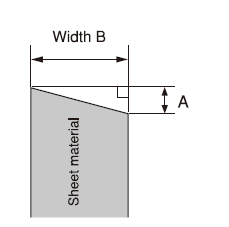
 Steel Plate Length tolerances
Steel Plate Length tolerances
|
Unit: mm |
|
|
Classification by nominal thickness |
JIS G 3141 length tolerances A |
|
800≤ - <2000 |
+10 |
|
2000≤ - <2800 |
+15 |
 Max. camber A
Max. camber A
|
Unit: mm |
|||
|
Classification by nominal thickness |
Steel sheet in lengths of |
Steel sheet or strip in lengths of |
Notes |
|
10≤ - <20 |
24 |
24 per any length of 2,000 |
Takasago special standard |
|
20≤ - <30 |
16 |
16 per any length of 2,000 |
|
|
30≤ - <40 |
8 |
8 per any length of 2,000 |
JIS G 3141 |
|
40≤ - <450 |
4 |
4 per any length of 2,000 |
|
* Excluding SUY and SUYP
 JIS G 3141 Standard
JIS G 3141 Standard
|
Steel type symbol |
Skin-pass symbol |
Steel grade |
Chemical composition, % |
|||||
|
C |
Si |
Mn |
P |
S |
||||
|
General |
SPCC |
S |
TAP8 |
≤0.10 |
≤0.08 |
0.20 - 0.50 |
≤0.035 |
≤0.035 |
|
8 |
TAK8 |
≤0.08 |
≤0.08 |
0.20 - 0.40 |
≤0.025 |
≤0.030 |
||
|
4 |
TAK10 |
0.08 - 0.12 |
≤0.10 |
0.30 - 0.60 |
≤0.030 |
≤0.035 |
||
|
2 |
TAK12 |
0.10 - 0.14 |
≤0.10 |
0.30 - 0.60 |
≤0.030 |
≤0.035 |
||
|
1 |
TAK20(*1) |
0.18 - 0.23 |
≤0.10 |
0.30 - 0.60 |
≤0.025 |
≤0.030 |
||
|
Drawing |
SPCD |
S |
TAP8 |
≤0.10 |
≤0.08 |
0.20 - 0.50 |
≤0.035 |
≤0.035 |
|
TAK8 |
≤0.08 |
≤0.08 |
0.20 - 0.40 |
≤0.025 |
≤0.030 |
|||
|
Deep |
SPCE |
S |
TAK8 |
≤0.08 |
≤0.08 |
0.20 - 0.40 |
≤0.025 |
≤0.030 |
(*1)TAK20 cannot be applied to the SPCC-SB type specified in JIS G 3141.
 JIS G 3141 Standard
JIS G 3141 Standard
|
Steel type symbol |
Chemical composition, % |
|||
|
C |
Mn |
P |
S |
|
|
SPCC |
≤0.15 |
≤0.60 |
≤0.100 |
≤0.035 |
|
SPCD |
≤0.10 |
≤0.50 |
≤0.040 |
≤0.035 |
|
SPCE |
≤0.08 |
≤0.45 |
≤0.030 |
≤0.030 |
 SAE Standard
SAE Standard
|
Steel type symbol |
Chemical composition, % |
|||
|
C |
Mn |
P |
S |
|
|
SAE1008 |
≤0.10 |
0.30 - 0.50 |
≤0.030 |
≤0.05 |
|
SAE1010 |
0.08 - 0.13 |
0.30 - 0.60 |
≤0.030 |
≤0.05 |
|
SAE1012 |
0.10 - 0.15 |
0.30 - 0.60 |
≤0.030 |
≤0.05 |
|
SAE1020 |
0.18 - 0.23 |
0.30 - 0.60 |
≤0.030 |
≤0.05 |
HuNan Province
+86-731-85648266
LiaoNing Province
+86-731-85648266
HeBei Province
+86-731-85648299
jiangsu Province
+86-731-85648299
TianJin City
Singapore
